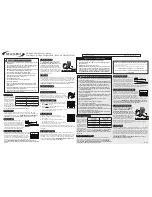
Basic Safety Instructions
1171.0000.52 - 09
Page 8
Class B equipment:
Equipment suitable for use in residential environments and environments
that are directly connected to a low-voltage supply network that supplies
residential buildings
Repair and service
1. The product may be opened only by authorized, specially trained personnel.
Before any work is performed on the product or before the product is opened,
it must be disconnected from the AC supply network. Otherwise, personnel will
be exposed to the risk of an electric shock.
2. Adjustments, replacement of parts, maintenance and repair may be performed
only by electrical experts authorized by Rohde & Schwarz. Only original parts
may be used for replacing parts relevant to safety (e.g. power switches, power
transformers, fuses). A safety test must always be performed after parts
relevant to safety have been replaced (visual inspection, protective conductor
test, insulation resistance measurement, leakage current measurement,
functional test). This helps ensure the continued safety of the product.
Batteries and rechargeable batteries/cells
If the information regarding batteries and rechargeable batteries/cells is not
observed either at all or to the extent necessary, product users may be exposed
to the risk of explosions, fire and/or serious personal injury, and, in some cases,
death. Batteries and rechargeable batteries with alkaline electrolytes (e.g. lithium
cells) must be handled in accordance with the EN 62133 standard.
1. Cells must not be taken apart or crushed.
2. Cells or batteries must not be exposed to heat or fire. Storage in direct sunlight
must be avoided. Keep cells and batteries clean and dry. Clean soiled
connectors using a dry, clean cloth.
3. Cells or batteries must not be short-circuited. Cells or batteries must not be
stored in a box or in a drawer where they can short-circuit each other, or
where they can be short-circuited by other conductive materials. Cells and
batteries must not be removed from their original packaging until they are
ready to be used.
4. Cells and batteries must not be exposed to any mechanical shocks that are
stronger than permitted.
5. If a cell develops a leak, the fluid must not be allowed to come into contact
with the skin or eyes. If contact occurs, wash the affected area with plenty of
water and seek medical aid.











































